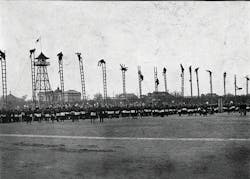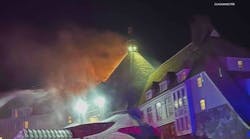IDITAROD, AK: APRIL 4, 1911 — Fire raged through the business section of this mining boomtown and destroyed nearly every building, with a loss of more than $75,000. A week later, residents voted 259 to 56 to incorporate and then immediately moved to consider the fire protection problem. By June, they voted to purchase two steam pumps, 1,000 feet of four-inch main and 2,500 feet of fire hose and contracted the Cascade Laundry to provide around-the-clock steam to the pumps. Iditarod came into existence in 1909 after a frontier-style gold rush and a year later briefly became the largest city in Alaska, with 10,000 inhabitants.
DALTON, GA: APRIL 9, 1911 — Just after midnight, flames broke out on the third floor of the Hotel Dalton. Within a few minutes, the fire was burning from one end of the building to the other. It was impossible for firemen to even attempt entry into the blazing area. This was the third fire in the hotel within 30 days. The fire quickly spread to nearby buildings and by 3:30 A.M., the entire main business block was smoldering ruins.
TOKYO, JAPAN: APRIL 10, 1911 — A strong southwest wind fanned the flames of a fire that started in the Yoshiwara section of the city and expanded with amazing speed. The Yoshiwara ("Good luck meadow") neighborhood was the most famous, most refined and most cultured of the city's licensed quarters, a famous red-light district. It was just around 11 A.M. when flames broke out and began to spread among the wood and paper structures. For three hours, the fire brigade battled the flames, but not before thousands of houses were in ruins. Fires plagued Tokyo during its long history, including the complete rebuilding of this neighborhood after flames destroyed it in 1657.
NEW YORK CITY: APRIL 13, 1911 — A fire inside the Manhattan Soap Co. on West 36th Street proved that fire drills had positive results. Following the tragic Triangle Shirtwaist Co. fire in the Asch Building that claimed the lives of 146 people a few weeks earlier (see "Learning from Tragedy," March 2011), the FDNY pressed factories across the city to hold fire drills. The management of the soap company devised an escape plan and had several drills to make their employees aware of what to do. It was just after 9 A.M. when a fire broke out in the basement above one of the boilers. Flames extended rapidly all the way to through the roof due to the oil- and fat-soaked flooring and stairs inside the six-story building. Within minutes, 60 women had safely evacuated the blazing structure as fire companies rolled into the block. The first-due officer, seeing the advanced fire condition, transmitted second and third alarms on arrival. Amazingly, there were no injuries.
SCHAERBEEK, BELGIUM: APRIL 18, 1911 — A fire believed to have been of incendiary origin and set inside City Hall threatened a major collection of priceless works of art in the structure. The city is one of 19 municipalities that make up Greater Brussels, the capital region of the country. City Hall, a huge neo-gothic structure inaugurated by King Leopold II in 1887, could have been considered a museum unto itself. Arriving firemen were faced with an advanced fire condition and two firemen were killed during a desperate effort to save some of the building's contents. Notable paintings and "gobelins" (vivid tapestries produced by the Gobelin factory in Paris, France) were destroyed.
BANGOR, ME: APRIL 30, 1911 — Three people were killed and 50 others were injured as flames pressed by high winds tore through the business district before spreading into a residential area. Mutual aid was requested from several cities and responded to the scene via railroad. Among the buildings destroyed were the post office, a high school, the Windsor Hotel, houses of worship, the telephone company and large lumberyards along the waterfront. The path of ruins ran more than two miles north of the initial fire. Losses were estimated in excess of $6 million. The city then faced a critical food shortage and martial law was declared to prevent looting. Among those who garnered much praise were Boy Scouts from Bangor and nearby towns who volunteered their services and acted as runners and messengers and helped with the evacuees.
PAUL HASHAGEN, a Firehouse® contributing editor, is a retired FDNY firefighter who was assigned to Rescue 1 in Manhattan. He is also an ex-chief of the Freeport, NY, Fire Department. Hashagen is the author of FDNY: The Bravest, An Illustrated History 1865–2002, the official history of the New York City Fire Department, and other fire service books. His latest novel, Fire of God, is available at dmcfirebooks.com.






